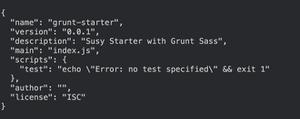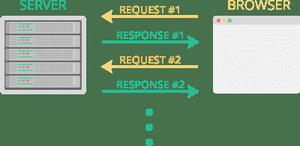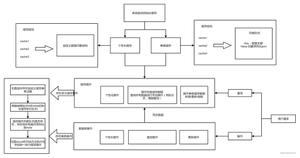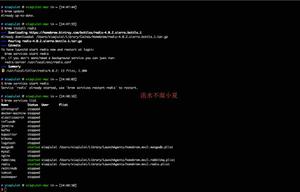SpringBoot中Shiro缓存使用Redis、Ehcache的方法
SpringBoot 中配置redis作为session 缓存器。 让shiro引用
本文是建立在你是使用这shiro基础之上的补充内容
第一种:Redis缓存,将数据存储到redis 并且开启session存入redis中。
引入pom
<dependency>
<groupId>org.springframework.boot</groupId>
<artifactId>spring-boot-starter-data-redis</artifactId>
</dependency>
<dependency>
<groupId>org.springframework.session</groupId>
<artifactId>spring-session-data-redis</artifactId>
</dependency>
配置redisConfig
@Configuration
@EnableCaching
public class RedisConfig extends CachingConfigurerSupport {
@Bean
public KeyGenerator keyGenerator() {
return new KeyGenerator() {
@Override
public Object generate(Object target, Method method, Object... params) {
StringBuilder sb = new StringBuilder();
sb.append(target.getClass().getName());
sb.append(method.getName());
for (Object obj : params) {
sb.append(obj.toString());
}
return sb.toString();
}
};
}
@Bean
//在这里配置缓存reids配置
public RedisCacheManager cacheManager(RedisConnectionFactory redisConnectionFactory) {
RedisCacheConfiguration redisCacheConfiguration = RedisCacheConfiguration.defaultCacheConfig()
.entryTtl(Duration.ofHours(1)); // 设置缓存有效期一小时
System.out.println("《========【开启redis】 ======== 》 ");
return RedisCacheManager
.builder(RedisCacheWriter.nonLockingRedisCacheWriter(redisConnectionFactory))
.cacheDefaults(redisCacheConfiguration).build();
}
@Bean
public RedisTemplate<String, String> redisTemplate(RedisConnectionFactory factory) {
StringRedisTemplate template = new StringRedisTemplate(factory);
Jackson2JsonRedisSerializer jackson2JsonRedisSerializer = new Jackson2JsonRedisSerializer(Object.class);
ObjectMapper om = new ObjectMapper();
om.setVisibility(PropertyAccessor.ALL, JsonAutoDetect.Visibility.ANY);
om.enableDefaultTyping(ObjectMapper.DefaultTyping.NON_FINAL);
jackson2JsonRedisSerializer.setObjectMapper(om);
template.setValueSerializer(jackson2JsonRedisSerializer);
template.afterPropertiesSet();
return template;
}
}
配置自定义缓存管理器,引入redis缓存管理器
定义自己的CacheManager
/**
* <p> 自定义cacheManage 扩张shiro里面的缓存 使用reids作缓存 </p>
* <description>
* 引入自己定义的CacheManager
* 关于CacheManager的配置文件在spring-redis-cache.xml中
* </description>
*/
@Component
public class ShiroSpringCacheManager implements CacheManager ,Destroyable{
/**
* 将之上的RedisCacheManager的Bean拿出来 注入于此
*/
@Autowired
private org.springframework.cache.CacheManager cacheManager;
public org.springframework.cache.CacheManager getCacheManager() {
return cacheManager;
}
public void setCacheManager(org.springframework.cache.CacheManager cacheManager) {
this.cacheManager = cacheManager;
}
@Override
public void destroy() throws Exception {
cacheManager = null;
}
@Override
public <K, V> Cache<K, V> getCache(String name) {
if (name == null ){
return null;
}
// 新建一个ShiroSpringCache 将Bean放入并实例化
return new ShiroSpringCache<K,V>(name,getCacheManager());
}
}
定义自己实现的Shiro的Cache,实现了Shiro包里的Cache
/**
* <p> 自定义缓存 将数据存入到redis中 </p>
*/
@SuppressWarnings("unchecked")
public class ShiroSpringCache<K,V> implements org.apache.shiro.cache.Cache<K, V>{
private static final Logger log = LoggerFactory.getLogger(ShiroSpringCache.class);
private CacheManager cacheManager;
private Cache cache;
public ShiroSpringCache(String name, CacheManager cacheManager) {
if(name==null || cacheManager==null){
throw new IllegalArgumentException("cacheManager or CacheName cannot be null.");
}
this.cacheManager = cacheManager;
//这里首先是从父类中获取这个cache,如果没有会创建一个redisCache,初始化这个redisCache的时候
//会设置它的过期时间如果没有配置过这个缓存的,那么默认的缓存时间是为0的,如果配置了,就会把配置的时间赋予给这个RedisCache
//如果从缓存的过期时间为0,就表示这个RedisCache不存在了,这个redisCache实现了spring中的cache
this.cache= cacheManager.getCache(name);
}
@Override
public V get(K key) throws CacheException {
log.info("从缓存中获取key为{}的缓存信息",key);
if(key == null){
return null;
}
ValueWrapper valueWrapper = cache.get(key);
if(valueWrapper==null){
return null;
}
return (V) valueWrapper.get();
}
@Override
public V put(K key, V value) throws CacheException {
log.info("创建新的缓存,信息为:{}={}",key,value);
cache.put(key, value);
return get(key);
}
@Override
public V remove(K key) throws CacheException {
log.info("干掉key为{}的缓存",key);
V v = get(key);
cache.evict(key);//干掉这个名字为key的缓存
return v;
}
@Override
public void clear() throws CacheException {
log.info("清空所有的缓存");
cache.clear();
}
@Override
public int size() {
return cacheManager.getCacheNames().size();
}
/**
* 获取缓存中所的key值
*/
@Override
public Set<K> keys() {
return (Set<K>) cacheManager.getCacheNames();
}
/**
* 获取缓存中所有的values值
*/
@Override
public Collection<V> values() {
return (Collection<V>) cache.get(cacheManager.getCacheNames()).get();
}
@Override
public String toString() {
return "ShiroSpringCache [cache=" + cache + "]";
}
}
到此为止,使用redis做缓存,和spring的集成就完成了。
可以使用以下注解将缓存放入redis
@Cacheable(value = Cache.CONSTANT, key = "'" + CacheKey.DICT_NAME + "'+#name+'_'+#val")
配置spring session管理器
@Bean
@ConditionalOnProperty(prefix = "xpro", name = "spring-session-open", havingValue = "true")
public ServletContainerSessionManager servletContainerSessionManager() {
return new ServletContainerSessionManager();
}
新建类 spring session设置session过期时间
/**
* spring session配置
*
* @author xingri
* @date 2017-07-13 21:05
*/
@EnableRedisHttpSession(maxInactiveIntervalInSeconds = 900) //session过期时间 如果部署多机环境,需要打开注释
@ConditionalOnProperty(prefix = "xpro", name = "spring-session-open", havingValue = "true")
public class SpringSessionConfig {
}
第一种:Ehcache做缓存,可以将数据存储到磁盘中,也可以存到内存中
新建ehcache.xml 文件
<?xml version="1.0" encoding="UTF-8"?>
<ehcache updateCheck="false" dynamicConfig="false">
<diskStore path="java.io.tmpdir"/>
<!--授权信息缓存-->
<cache name="authorizationCache"
maxEntriesLocalHeap="2000"
eternal="false"
timeToIdleSeconds="1800"
timeToLiveSeconds="1800"
overflowToDisk="false"
statistics="true">
</cache>
<!--身份信息缓存-->
<cache name="authenticationCache"
maxEntriesLocalHeap="2000"
eternal="false"
timeToIdleSeconds="1800"
timeToLiveSeconds="1800"
overflowToDisk="false"
statistics="true">
</cache>
<!--session缓存-->
<cache name="activeSessionCache"
maxEntriesLocalHeap="2000"
eternal="false"
timeToIdleSeconds="1800"
timeToLiveSeconds="1800"
overflowToDisk="false"
statistics="true">
</cache>
<!-- 缓存半小时 -->
<cache name="halfHour"
maxElementsInMemory="10000"
maxElementsOnDisk="100000"
eternal="false"
timeToIdleSeconds="1800"
timeToLiveSeconds="1800"
overflowToDisk="false"
diskPersistent="false" />
<!-- 缓存一小时 -->
<cache name="hour"
maxElementsInMemory="10000"
maxElementsOnDisk="100000"
eternal="false"
timeToIdleSeconds="3600"
timeToLiveSeconds="3600"
overflowToDisk="false"
diskPersistent="false" />
<!-- 缓存一天 -->
<cache name="oneDay"
maxElementsInMemory="10000"
maxElementsOnDisk="100000"
eternal="false"
timeToIdleSeconds="86400"
timeToLiveSeconds="86400"
overflowToDisk="false"
diskPersistent="false" />
<!--
name:缓存名称。
maxElementsInMemory:缓存最大个数。
eternal:对象是否永久有效,一但设置了,timeout将不起作用。
timeToIdleSeconds:设置对象在失效前的允许闲置时间(单位:秒)。仅当eternal=false对象不是永久有效时使用,可选属性,默认值是0,也就是可闲置时间无穷大。
timeToLiveSeconds:设置对象在失效前允许存活时间(单位:秒)。最大时间介于创建时间和失效时间之间。仅当eternal=false对象不是永久有效时使用,默认是0.,也就是对象存活时间无穷大。
overflowToDisk:当内存中对象数量达到maxElementsInMemory时,Ehcache将会对象写到磁盘中。
diskSpoolBufferSizeMB:这个参数设置DiskStore(磁盘缓存)的缓存区大小。默认是30MB。每个Cache都应该有自己的一个缓冲区。
maxElementsOnDisk:硬盘最大缓存个数。
diskPersistent:是否缓存虚拟机重启期数据 Whether the disk store persists between restarts of the Virtual Machine. The default value is false.
diskExpiryThreadIntervalSeconds:磁盘失效线程运行时间间隔,默认是120秒。
memoryStoreEvictionPolicy:当达到maxElementsInMemory限制时,Ehcache将会根据指定的策略去清理内存。默认策略是LRU(最近最少使用)。你可以设置为FIFO(先进先出)或是LFU(较少使用)。
clearOnFlush:内存数量最大时是否清除。
-->
<defaultCache name="defaultCache"
maxElementsInMemory="10000"
eternal="false"
timeToIdleSeconds="600"
timeToLiveSeconds="600"
overflowToDisk="false"
maxElementsOnDisk="100000"
diskPersistent="false"
diskExpiryThreadIntervalSeconds="120"
memoryStoreEvictionPolicy="LRU"/>
</ehcache>
配置自定义缓存管理器,引入ehcache缓存管理器
/**
* ehcache配置
*
*/
@Configuration
@EnableCaching
public class EhCacheConfig {
/**
* EhCache的配置
*/
@Bean
public EhCacheCacheManager cacheManager(CacheManager cacheManager) {
MBeanServer mBeanServer = ManagementFactory.getPlatformMBeanServer();
ManagementService.registerMBeans(cacheManager, mBeanServer, true, true, true, true);
return new EhCacheCacheManager(cacheManager);
}
/**
* EhCache的配置
*/
@Bean
public EhCacheManagerFactoryBean ehcache() {
System.out.println("《========【开启ehcache】 ======== 》 ");
EhCacheManagerFactoryBean ehCacheManagerFactoryBean = new EhCacheManagerFactoryBean();
ehCacheManagerFactoryBean.setConfigLocation(new ClassPathResource("ehcache.xml"));
return ehCacheManagerFactoryBean;
}
@Bean
public org.apache.shiro.cache.CacheManager getCacheShiroManager(EhCacheManagerFactoryBean ehcache) {
EhCacheManager ehCacheManager = new EhCacheManager();
ehCacheManager.setCacheManager(ehcache.getObject());
return ehCacheManager;
}
}
最后 最重要的是引入shriro 中
/**
* shiro权限管理的配置
*
*/
@Configuration
public class ShiroConfig {
/**
* 安全管理器
*/
@Bean
public DefaultWebSecurityManager securityManager(CookieRememberMeManager rememberMeManager, CacheManager cacheShiroManager, SessionManager sessionManager) {
DefaultWebSecurityManager securityManager = new DefaultWebSecurityManager();
securityManager.setAuthenticator(modularRealmAuthenticator());
List<Realm> realms=new ArrayList<>();
securityManager.setRealms(realms);
securityManager.setCacheManager(cacheShiroManager);
securityManager.setRememberMeManager(rememberMeManager);
securityManager.setSessionManager(sessionManager);
return securityManager;
}
/**
* spring session管理器(多机环境)
*/
@Bean
public ServletContainerSessionManager servletContainerSessionManager() {
return new ServletContainerSessionManager();
}
/**
* session管理器(单机环境) 使用cookie存储缓存。。如果多级请注释
*/
@Bean
public DefaultWebSessionManager defaultWebSessionManager(CacheManager cacheShiroManager, XProProperties xProProperties) {
DefaultWebSessionManager sessionManager = new DefaultWebSessionManager();
sessionManager.setCacheManager(cacheShiroManager);
sessionManager.setSessionValidationInterval(xProProperties.getSessionValidationInterval() * 1000);
sessionManager.setGlobalSessionTimeout(xProProperties.getSessionInvalidateTime() * 1000);
sessionManager.setDeleteInvalidSessions(true);
sessionManager.setSessionValidationSchedulerEnabled(true);
Cookie cookie = new SimpleCookie(ShiroHttpSession.DEFAULT_SESSION_ID_NAME);
cookie.setName("shiroCookie");
cookie.setHttpOnly(true);
sessionManager.setSessionIdCookie(cookie);
return sessionManager;
}
/**
* 缓存管理器 使用Ehcache实现 如果使用redis则注释下面内容!!!!
*/
@Bean
public CacheManager getCacheShiroManager(EhCacheManagerFactoryBean ehcache) {
EhCacheManager ehCacheManager = new EhCacheManager();
ehCacheManager.setCacheManager(ehcache.getObject());
return ehCacheManager;
}
/**
* 项目自定义的Realm
*/
@Bean
public ShiroDbRealm shiroDbRealm() {
return new ShiroDbRealm();
}
@Bean
public ShiroTockenRealm shiroTockenRealm( ) {
return new ShiroTockenRealm();
}
@Bean
public ShiroJwtRealm shiroJwtRealm( ) {
return new ShiroJwtRealm();
}
/**
* 系统自带的Realm管理,主要针对多realm
* */
@Bean
public ModularRealmAuthenticator modularRealmAuthenticator(){
ModularRealmAuthenticator modularRealmAuthenticator=new ModularRealmAuthenticator();
modularRealmAuthenticator.setAuthenticationStrategy(new AtLeastOneSuccessfulStrategy());
return modularRealmAuthenticator;
}
/**
* rememberMe管理器, cipherKey生成见{@code Base64Test.java}
*/
@Bean
public CookieRememberMeManager rememberMeManager(SimpleCookie rememberMeCookie) {
CookieRememberMeManager manager = new CookieRememberMeManager();
manager.setCipherKey(Base64.decode("Z3VucwAAAAAAAAAAAAAAAA=="));
manager.setCookie(rememberMeCookie);
return manager;
}
/**
* 记住密码Cookie
*/
@Bean
public SimpleCookie rememberMeCookie() {
SimpleCookie simpleCookie = new SimpleCookie("rememberMe");
simpleCookie.setHttpOnly(true);
simpleCookie.setMaxAge(7 * 24 * 60 * 60);//7天
return simpleCookie;
}
/**
* 在方法中 注入 securityManager,进行代理控制
*/
@Bean
public MethodInvokingFactoryBean methodInvokingFactoryBean(DefaultWebSecurityManager securityManager) {
MethodInvokingFactoryBean bean = new MethodInvokingFactoryBean();
bean.setStaticMethod("org.apache.shiro.SecurityUtils.setSecurityManager");
bean.setArguments(new Object[]{securityManager});
return bean;
}
/**
* 保证实现了Shiro内部lifecycle函数的bean执行
*/
@Bean
public LifecycleBeanPostProcessor lifecycleBeanPostProcessor() {
return new LifecycleBeanPostProcessor();
}
/**
* 启用shrio授权注解拦截方式,AOP式方法级权限检查
*/
@Bean
@DependsOn(value = "lifecycleBeanPostProcessor") //依赖其他bean的初始化
public DefaultAdvisorAutoProxyCreator defaultAdvisorAutoProxyCreator() {
return new DefaultAdvisorAutoProxyCreator();
}
@Bean
public AuthorizationAttributeSourceAdvisor authorizationAttributeSourceAdvisor(DefaultWebSecurityManager securityManager) {
AuthorizationAttributeSourceAdvisor authorizationAttributeSourceAdvisor =
new AuthorizationAttributeSourceAdvisor();
authorizationAttributeSourceAdvisor.setSecurityManager(securityManager);
return authorizationAttributeSourceAdvisor;
}
}
以上是 SpringBoot中Shiro缓存使用Redis、Ehcache的方法 的全部内容, 来源链接: utcz.com/z/344265.html









